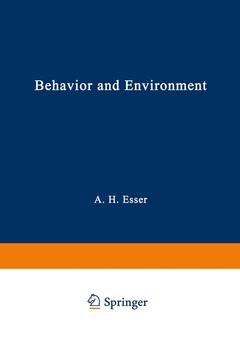Behavior and Environment, 1971 The Use of Space by Animals and Men
Langue : Anglais
Coordonnateur : Esser A.

The International Symposium on "The Use of Space by Animals and Men," sponsored by the Animal Behavior Society, took place at the 135th Annual Meeting of the AAAS in Dallas, Texas, on December 29-31, 1968. This book presents the text of all papers and edited discus sions, as well as the contributions made by several individuals who were unable ·to attend the Symposium. The idea of holding the Symposium evolved following my presenta tion of a paper to the Animal Behavior Society in 1965 [2] on the use of space by psychiatric patients. Members in attendance at that ses sion, chaired by G. Gottlieb, shared his interest in my compilation of human data presented in a measurable spatial context. This plea sant experience persuaded me that a discussion of space might be shared as a frame of reference which could open avenues of communica tion between behavioral scientists, the design community, and the de cision makers in our society.
Session I: Territoriality and Dominance.- The Importance of Defining Spatial Behavioral Parameters.- Ten Phases of the Animal Path: Behavior in Familiar Situations.- Dominance and Territoriality as Complemented in Mammalian Social Structure.- Prepared Contributions for Discussion of Session I.- Social Organization and Community Composition.- Answer to Barbehenn.- Is Territoriality Definable?.- Social Organization in a Laboratory Colony of Wood Rats (Neotoma Fuscipes).- Discussion of Session I.- Panel.- Session II: Space and Contact Behavior.- Theories of Animal Spacing: The Role of Flight, Fight and Social Distance.- Inter-Animal Control of Space.- Spacing as Affected by Territorial Behavior, Habitat and Nutrition in Red Grouse (Lagopus I. Scoticus).- Prepared Contributions for Discussion of Session II.- Intergroup Relations in Rhesus Monkeys (Macacca Mulatta).- The Regulation of Territorial Marking in the Mongolian Gerbil (Meriones Unguiculatus).- Mapping of Human Movement.- Use of Telemetry As A Means of Studying Spacing and Behavior of Animals.- Discussion of Session II.- Panel.- Session III: Population Density and Crowding.- Physiological Effects of Continued Crowding.- The Effects of Varying Density and Space on Sociality and Health in Animals.- Behavior Under Involuntary Confinement.- Prepared Contributions for Discussion of Session III.- Social Stimulus and Metabolism of the Brain.- Discussion of Session III.- Panel.- Session IV: Orientation and Communication.- The Role of Orienting Behavior in Human Interaction.- Transcultural Patterns of Ritualized Contact Behavior.- Environmental Communication.- Discussion of Session IV.- Panel.- Session V: Communal Behavior and the Environment.- Space Use and the social Community in Animals and Men.- Spatial Parameters in Naturalistic Social Research.- Ecological Aspects of Interpersonal Functioning.- Prepared Contributions for Discussion of Session V.- Significance of the Ipsefact.- Community Control Over Space and Population.- Discussion of Session V.- Panel.- AAAS Frontiers of Siecnce Lecture III.- Space and the Strategy of Life.- Indices.- Animal.- Geographical.- Name.- Subject.
Date de parution : 04-2012
Ouvrage de 412 p.
17.8x25.4 cm
Disponible chez l'éditeur (délai d'approvisionnement : 15 jours).
Prix indicatif 52,74 €
Ajouter au panierThème de Behavior and Environment :
Mots-clés :
animal behavior; behavior; brain; communication; environment; interaction
© 2024 LAVOISIER S.A.S.
